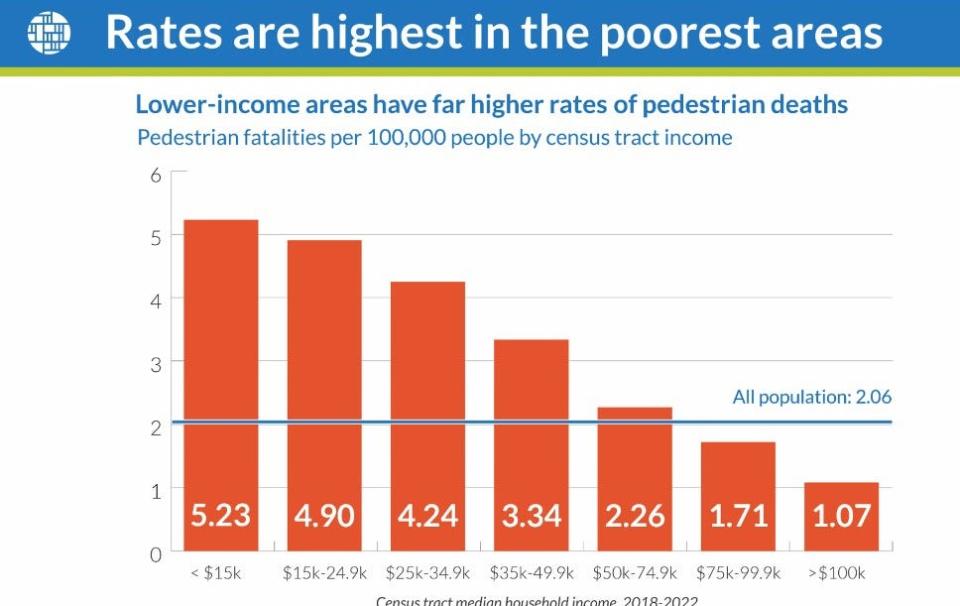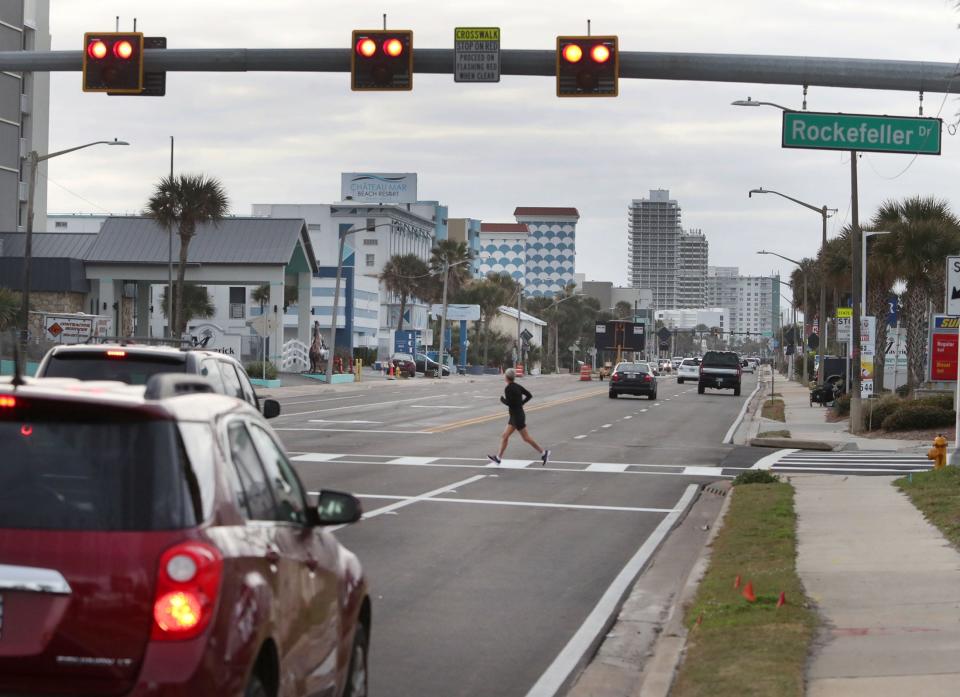The metro area of Volusia County again ranks among the nation’s worst when it comes to fatal pedestrian accidents, according to a semi-annual report that advocates for safer streets through transportation design.
“Dangerous By Design,” a report by Smart Growth America, cited the Deltona-Daytona Beach-Ormond Beach metro area as being tied for fifth-worst in the United States when it comes to pedestrian deaths over the five-year period ending in 2022. The area was rated the nation’s worst in the 2022 report and has been among the most dangerous going back to at least 2017.
Calvin Gladney, president and CEO of Smart Growth America, called the pedestrian fatalities an “epidemic” and drew a comparison between the safety of walking on America’s sidewalks to flying in airplanes. Where there were 358 aviation deaths in 2022, and none were on commercial flights, more than 7,500 people died while walking − nearly 20 people every day.
“If 20 people a day fell out of the sky, we would shut down the aviation industry,” Gladney said. “Unfortunately, we have built an automobile-centric culture in this country where we allow for, and for whatever reason, we just believe it’s a cost of doing business that people walking get killed every day.”
The report notes that the United States is seeing a historic shift. In 1994, 79% of crash deaths involved persons inside a vehicle, while 21% were outside a vehicle. Today, the proportion is 64% inside versus 36% outside.
Worst metro in the worst state for walking
If going from No. 1 worst to tied for No. 5 worst sounds like an improvement, it is at best a mixed bag. The number of pedestrian fatalities dropped from the 2022 report, to 134 from 140.
But comparing the most recent five-year period (2018-2022) to the previous five-year stretch (2013-2017), the Volusia metros saw a 25% increase in pedestrian deaths, going from 107 to 134.
Also, the Deltona-Daytona-Ormond metro area was cited as the worst in Florida, which has a claim to the worst state for pedestrian safety, with eight metros among the 20 most dangerous, topping California, which had five. The only Florida metro area outside the worst 20, Lakeland-Winter Haven, was tied for 21st.
The five worst were: 1. Memphis, Tennessee; 2. Albuquerque, New Mexico; 3. Tucson, Arizona; 4. Bakersfield, California; 5. Deltona-Daytona Beach-Ormond Beach tied with Baton Rouge, Louisiana.
The 20 worst metro areas are nearly all in the southern half of the continental United States, with Sacramento, California, landing as the northernmost.
There are several explanations for this. Florida is a state with weather warm enough to invite walking outdoors nearly the entire year, as opposed to, say, Provo, Utah, or Madison, Wisconsin, or Minneapolis-St. Paul, Minnesota, the three safest places to walk.
“It appears that places that have high pedestrian traffic per capita have the most fatal pedestrian crashes per capita,” said Lt. Jim Beauford, chief of public affairs for the Florida Highway Patrol. “In another words, areas with great weather and high tourism have more pedestrians year round than areas that don’t.”
Beth Osborne, vice president of transportation and thriving communities for Smart Growth America, said the concentration of pedestrian accidents in the southern United States reflects development patterns of the second half of the last century.
“The bulk of development and growth in these regions took place post-1960 and therefore when we are deep into the auto era,” she said.
Smart Growth America has long advocated for states and communities to plan and retrofit roads where cars and pedestrians mix to employ designs that slow traffic, such as narrower lanes, curves, sharper turns and medians.
“Design has a huge impact on how people drive. It’s more influential than the posted speed limit, which only pops up every quarter of a mile or so,” Osborne said.
“When you’re on a roadway, and your lane is wide … and it’s straight and you’re looking way down to the end of that roadway, you are being told − the design is screaming at you − that you can go fast,” she said. “When that roadway is narrowed … and there’s trees along the side and there’s buildings brought up close and there’s a median and things like that, that make the driver feel constrained, you don’t need a speed limit sign to indicate that you should go slower. It becomes natural to go slower, and we have chosen in this country to not utilize those well-known principles.”
Racial, age disparities in pedestrian fatalities
The report notes that Black and Native American people are more than twice as likely to be killed while walking than white, non-Hispanic or Asian/Pacific Islander people.
Gladney said many places in the South developed after the 1950s, when America’s car culture had become established, while “structural racism” was part of decisions on where to build roads and how they should be designed − going through poor neighborhoods which had less political clout and going through them as fast as possible.
“That’s why you see a lot of the disproportionate inequity and the disproportionate pedestrian fatalities that occur in the South because of where those streets and those arterials, those non-interstate arterials, were put and that was by design.”
Also, people from low-income neighborhoods have a greater chance of being killed by a motor vehicle than those in well-to-do areas.

Meanwhile, age disparities also are seen in the data: Children are far less likely to be killed in pedestrian accidents than older adults.
People between ages 50 and 64 have the highest likelihood, 2.89 pedestrian fatalities per 100,000, while those 75 and older are close, at 2.79. Those between ages 0 and 19 have a rate of 0.4 deaths per 100,000.

Efforts under way to make improvements
Cindi Lane, public information director for the Florida Department of Transportation’s Central Florida district, said in an emailed response to questions that safety is the agency’s top priority.
“Every FDOT project is a safety project that considers all users, and the department is adding more safety features to our transportation system all the time,” she said.
One of those is the Pedestrian Hybrid Beacon, a device that reduces pedestrian deaths by 55%, according to the Federal Highway Administration. The beacon helps pedestrians cross high-speed roadways at midblock crossings by allowing someone on foot to press a button that activates a yellow, then a red signal, stopping traffic.
The FDOT Central Florida district’s first Pedestrian Hybrid Beacon was installed on International Speedway Boulevard just east of Clyde Morris Boulevard, near Mainland High School and Daytona State College, while have been added throughout the district, Lane said.
Florida has added other safety features, including Rectangular Rapid Flashing Beacon crosswalks, lowered speed limits in some areas and added subtle lane alignment shifts, bicycle lanes, mid-block crosswalks, raised crosswalks, shared use paths and sidewalks, Lane said.
Some of these and other enhancements were added to a stretch of Orange Blossom Trail in Orlando, between Holden Avenue and 34th Street, which had 55 pedestrian accidents, including nine fatalities and 14 serious injuries, from 2018 to 2023.
“Since these added improvements were completed last year, there have been no fatalities in this section of Orange Blossom Trail,” Lane said.
FDOT completed a pedestrian safety project on a 1.5-mile stretch of State Road A1A south of Granada Boulevard in Ormond Beach, adding a new crosswalk and Pedestrian Hybrid Beacon, audible pedestrian signals, detectible warning pads and seven new mid-block crosswalks with beacons.
Future projects might also be designed with pedestrians in mind. Last year, the U.S. Department of Transportation awarded both the River to Sea Transportation Planning Organization and City of DeBary grants totaling $320,000 and $263,600, respectively, for studies.
The Safe Streets and Roads for All program is in the middle of a five-year program to distribute $5 billion to communities to “address the preventable crisis of deaths on our nation’s roads, streets and highways,” all part of the Infrastructure and Investment Jobs Act of 2021.
This article originally appeared on The Daytona Beach News-Journal: Daytona Beach metro area lands among worst in fatal pedestrian crashes
Signup bonus from




